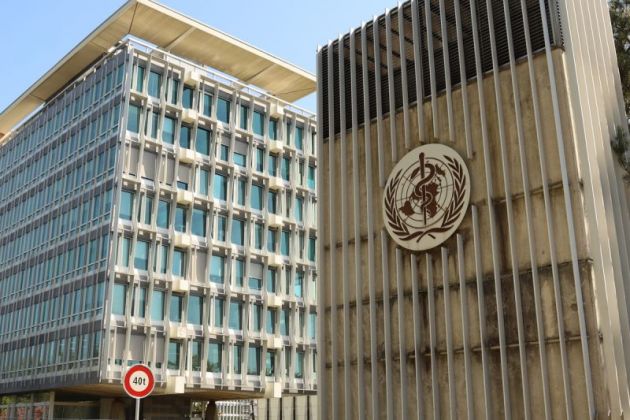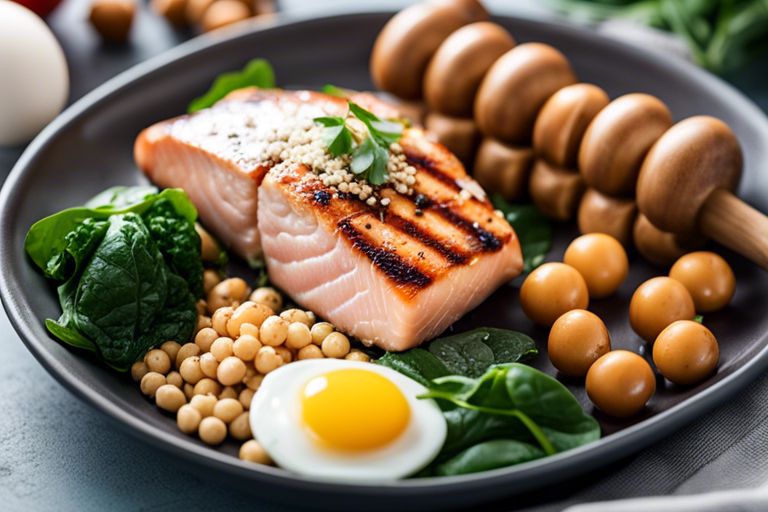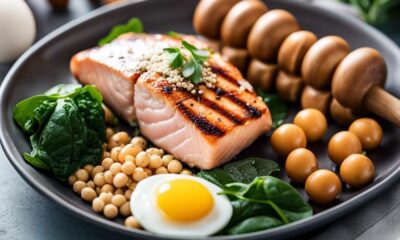Health & Society
Do you get enough vitamin D?
Vitamin D levels can be related to a person’s sex desire. Dr. Sarah Gottfried explains this. She is a Harvard-trained specialist in functional and integrated medicine.
A vitamin D deficiency in women leads to a reduction in estrogen, which results in a decreased sexual desire. Men also suffer from low testosterone due to a lack of vitamin D.
This may explain why people have a greater desire to be sexual in the summer. The summer months are marked by a peak in libido due to elevated vitamin D levels. Men with vitamin D levels of 30.0 mcg/L and above have significantly more testosterone compared to men who have vitamin D levels below 20.0-29.9mcg/L.
The levels of testosterone and estrogen also affect mood. Low testosterone is associated with depression and anxiety. Estrogen also helps increase serotonin, gamma aminobutyric acid and other neurotransmitters which contribute to feelings calmness and happiness.
Vitamin D activates genes that release serotonin and dopamine. Depression is often associated with a lack of these neurotransmitters. This link could help explain seasonal depression, which is characterized by a depressed mood in the winter months.
Experts recommend that, in winter, if a person is wearing thick, dense clothing to cover his skin, he take extra vitamin D supplements.
The only difference between the two is that with supplementation, the vitamin D-3 is already formed. This allows the body to skip this step. In both methods, D-3 is then transported to the liver where it is converted into 25-hydroxyvitamin D.
You don’t need to live at the Equator in order to get enough vitamin. Consult your doctor about the correct dosage.
Photo by Pavel Danilyuk: https://www.pexels.com/photo/different-medicines-placed-on-white-surface-5998499/
Health & Society
The World Health Organization allows experimental drugs to be used

From time to time one has breakfast with some international news published by journalistic media of all kinds, of those that catch one’s attention. In some cases I usually read them and put them aside, and in others they simply become part of my archive of forgotten papers, a sort of newspaper pages forgotten in boxes, which from time to time pass to a better life. They collect dust, take up space and with the passing of the years they raise some comments among the people around you: …surely if a psychologist saw your work room, he would not hesitate to diagnose you with Diogenes Syndrome, I have even heard that from friends and family. Surely this Diogenes kept so many things that he got out of control. This is not my case.
Of course, from time to time, in my personal search for more space, I attack those boxes, press containers and many of them, after a discreet review, go to occupy the place that history gives them in the paper container. However, on other occasions some already forgotten headline comes back to remind me again why I kept it. In this case the headline to a column in the newspaper El País of August 13, 2014 (10 years ago) The WHO (World Health Organization) admits the use of experimental drugs. Shielding themselves behind the approval of an ethical committee belonging to the same organization (Juan Palomo, yo me lo guiso, yo me lo como – typical Spanish saying, meaning that one does everything without permisions of anybodyelse) they approved at that time the use of experimental treatments on the victims of an Ebola outbreak that was occurring at that time in West Africa, without having proven their efficacy at all. To justify this treatment, the then WHO Deputy Director of Health Systems argued that other previous treatments were not working and that therefore … it is not only ethical, but a moral imperative.
The WHO statement did not refer, according to the clipping itself, to the experimental serum that had been approved for use in human guinea pigs, but that certain ethical criteria should also be taken into account, including transparency about the nature of the drug (What transparency can there be, when the nature of its results is not known? Ah! These doctors). Of course there was also an emphasis on respect for the individual, dignity and community involvement and, I forgot, consent. Although if you live in West Africa, one of the most depressed areas of the world, where you have absolutely nothing to survive on, whatever those in control of the “medical shaman” shack tell you will be fine with them. What is the difference between dying of Ebola, malnutrition or any other disease for which you are not prepared or serving as a lab rat for the big pharmaceutical corporations, including the phony health guard empire misnamed WHO?
Furthermore, in the same clipping it was confirmed that the WHO had given the go-ahead on the use of certain experimental drugs on those humans in Africa, after a spokesman, a week earlier had advised against the use of any product …that has not gone through the normal process of licensing and medical testing.
Of course I am not going to go into this subject in depth here, but go ahead and say that a book could be written on the subject. If you have the time and opportunity I advise you to put the phrase that serves as the headline of this opinion article: WHO allows experimental drugs to be used, whatever your language, and you will see how thousands of entries on this subject will come up. The COVID 19 pandemic itself, which was not a pandemic and did not plunge the world into a terrifying end of times, was undoubtedly one of the last projects of the WHO and some big pharmaceutical companies on how to use experimental drugs on humans, with the difference that on this occasion they were used on those who could pay for them, enriching the industry in a shameful and disgusting way. Governments lied to us, some presidents even spoke openly of non-existent expert committees (as in the case of Spain), they spoke of transparency and ethics, they used us by calling us stupid and pointing the finger at us if we did not agree with their theses. All limits were exceeded. They hijacked democracy and freedom and subjected us to unnecessary stress from which we emerged, to later define us in general as mentally ill.
Someday I imagine that the truth will have to be brought to light or at least continue to publish material where we can read between the lines of how we were swindled, with the connivance of the WHO, which as on previous occasions, a week before declaring the COVID-19 pandemic in Europe, declared that absolutely nothing was going to happen.
What can happen in a week for such a radical change of opinion, and even more so in an organization that, supposedly, has the obligation to watch over all of us?
Sometimes the cuts, although full of dust, are often useful to give us back a minimum of the personal integrity that was taken away from us for a couple of years and that still has not been given back to us, when we now know that there were vaccines that have generated serious health problems and some deaths. Yes, for the greater good. I expect, of course, millions of dollars in compensation to those who have been left with lifelong sequelae or to the relatives of those whose lives have been taken.
By the way, I leave the question up in the air: why in 2014 did we not already have a vaccine against Ebola? A presumed vaccine was patented in 2019, rVSV-ZEBOV, in the USA, if we consider that the disease was detected in 1976 in the Democratic Republic of Congo, why did it take 43 years to obtain results?
Health & Society
Doctors are not trained in how to discontinue psychiatric drugs

Tens of thousands of Europeans are every month seeking advice on how to discontinue or get off antidepressants outside their regular health services. That’s because doctors are not trained in how to deprescribe antidepressants and other psychiatric drugs research has found. The research suggest that tapering (slowly stopping) has to be done gradually, and at a rate that the individual user can tolerate, and reductions should be made by smaller and smaller amounts. It can take months and even years to get fully off the drugs.
Can not get off common antidepressants
At large international psychiatric congresses it for years has been common to present new studies on psychiatric drugs and discuss why and when to prescribe medications. At this year’s European Psychiatric Congress that was recently held in Budapest, Hungary a so-called State of the Art lecture set a new trend looking at how to properly discontinue or deprescribe psychotropic drugs.
An expert, Dr. Mark Horowitz a Clinical Research Fellow in Psychiatry at the National Health Service (NHS) in England had been given the task to address the necessary skills and guidelines to supported reduction or discontinuation of psychopharmacological treatment.
The backdrop to this is a scene in which many people cannot come off common antidepressants in the way the official medical guidelines recommend. Studies in Holland found that only some 7% of people could stop in this way and in England they found that 40% of people could stop in this way however with quite pronounced withdrawal effects.
Part of the problem is that doctors often believe that the withdrawal effects are “brief and mild”. And they do not know that withdrawal symptoms may include anxiety, depressed mood, and insomnia. The result is that they often tell their patients using antidepressants that there shouldn’t be a problem with coming off the antidepressant drug, and when the patients do report withdrawal effects they believe these to be the original underlying condition. A very large number of persons are due to this problem diagnosed as having a relapse (a return of someone’s underlying condition) and are being put back on antidepressants, sometimes for years or decades, or even lifelong.
Doctor’s advice unhelpful
The consequence of this is that many people who really want to get off the antidepressants leave their regular healthcare system and seek advice on peer support forums on how to come off their medications. Two peer support websites in English alone has some 900.000 hits a month, and almost half of them are from Europe.
There’s 180,000 people on these sort of websites. The research team of Dr Mark Horowitz surveyed 1,300 of them and found that three quarters of them considered their doctor’s advice was unhelpful. The story of many of them was similar. The most common tapering period that they had been recommended was 2 weeks and 4 weeks exactly like the guidelines of the public agency of the Department of Health and Social Care in England responsible for guidance, NICE, recommended, until it was updated recently.
Getting off antidepressants despite the doctors’ reassurances was a nightmare for many. Stories echo each other that the effects were so horrendous that the user had to get back on the antidepressant or otherwise would end up in a terrible state. The result is as many users expressed that “I’ve lost faith in my doctor.”
The underlying problem that has often been neglected is that years of use causes adaptation to the antidepressant drug and this adaptation persists for longer than it takes the drug to be eliminated from the body. That’s what causes withdrawal effects.
“When you stop the drug, let’s say months or years after the patient had been started on drug treatment following a stressful period in their life, the antidepressant is metabolized by the liver and kidneys in a few days or weeks. But what doesn’t change in a few days or weeks is the residual changes to the serotonin receptors and other systems downstream of this,” Dr. Horowitz explains.
In studies on humans, there are changes to the serotonergic system that persists for up to four years after the antidepressants are stopped.
The longer the harder
And the research indicates that the longer people are on the antidepressants, the harder it is to stop and the more severe the withdrawal effects.
For people who are on antidepressants for more than three years, in surveys two thirds are reporting withdrawal symptoms and half of those people are reporting symptoms that are moderately severe or severe.
“You can see clearly the more you’re adapted to a drug, the more difficult it is to stop it,” Dr Mark Horowitz explains.
And it is common as Dr Horowitz noted, “We have conducted a survey, of a group of people who are accessing therapy in the National Health Service (NHS) of England, two-fifths of them who have been on antidepressants have tried to stop and been unable to do so, and that correlated strongly with withdrawal effects.”
To minimize the risk of withdrawal effects, which more than half will experience using the commonly recommended procedures, certain principles about tapering antidepressants have to be known. The research indicates that the best approach to tapering is to perform it gradually (over months or sometimes years), and at a rate that the individual user can tolerate. Furthermore, it has to be done in smaller and smaller amounts.
Why tapering gradually

Research using PET scanning on persons using different doses of antidepressants showed that the inhibition of the serotonin transporter doesn’t occur as a linear line, but according to a hyperbolic curve. This follows a pharmacological principle known as the law of mass action.
In more regular language, it means that as one adds more and more drug to the body’s system, more and more neurotransmitter receptors are saturated. And so, by the time one reaches a high dose, every extra milligram of drug has less and less incremental effect. And that’s why one get this hyperbola pattern. This pattern is true for all psychiatric drugs.
This explains why users experience problems in the last stages of withdrawing from a drug. Doctors in general practice have come to use an approach of linear decrease, like 20, 15, 10, 5, 0 mg.
Dr Mark Horowitz explains the findings not only from a neurobiological viewpoint, but very much how users have explained it, “going from 20 to 15 milligrams has a very small effect on the brain, 15 to 10 a little bit larger, 10 to 5 larger again, and going from 5 to 0 is like jumping off a cliff. You think you’re down near the bottom, but actually you’ve walked out the eighth story window, in my view.”
The first few milligrams are easy to come off, and the last few milligrams are much harder.
“When doctors don’t understand this relationship, they think people must need the drug because they’ve had huge trouble and they’re pushing people back on it,” Dr Mark Horowitz added.
Based on both neurobiological research and clinical observations it thus makes more pharmacological sense to not reduce drugs by a linear amount of dose, but to reduce drugs by a linear amount of effect on the brain.
The approach of reducing the drug rate so it causes an ‘even effect’ on the brain requires decreasing by smaller and smaller amounts down to tiny final doses. So final reduction from this tiny dose to zero doesn’t cause a bigger change in effect on the brain as previous reductions.
One could approximate this by talking about proportional reduction. So, for example, reducing by about 50 percent at every step, going down from 20 to 10 to 5 to 2.5 to 1.25 to 0.6 approximately causes even changes of effect on the brain. Some people will need even more gradual dose reductions – for example, reducing by 10% of the most recent dose every month, so that the size of the reduction gets smaller as the total dose gets smaller.
Caution on withdrawing from psychiatric drugs
In noting this Dr Mark Horowitz cautions, “It is important to say it’s very hard to guess what rate an individual can tolerate. As it’s something that can take two weeks or four years. That’s why it’s very important to take the approach of adjusting to the individual, making small reductions and seeing how they respond before deciding on further steps.”
If withdrawal symptoms become too severe, then the reduction should be halted or the dose increased until symptoms resolve and the reduction should then proceed to a slower pace.
In England the new NICE guidelines, which is not just for psychiatrists, but for GPs, recommends to slowly reduce the dose in a stepwise fashion, at each step prescribing a proportion of the previous dose.
For clinicians not only in England but everywhere there is now extensive guidance available. Dr Mark Horowitz has co-authored the recently published “Maudsley Deprescribing Guidelines”. It describes how to safely reduce every antidepressant, benzodiazepine, z-drug and gabapentanoid that’s licensed in Europe and America. The “Maudsley Deprescribing Guidelines” can be bought through the medical publisher Wiley and even through Amazon. A forthcoming version of the Guidelines due in 2025 will also include antipsychotic drugs and other psychiatric drug classes.
Health & Society
The Best Foods To Eat For Muscle Recovery And Growth

Overwhelmed with the endless options in the grocery store? In the context of fueling your muscles for recovery and growth, the right foods can make all the difference. Incorporating protein-packed choices like chicken, eggs, and Greek yogurt into your diet can help repair and build muscle tissue. Don’t forget about healthy fats from sources like avocados and nuts to support muscle function. Amp up your meals with colorful fruits and vegetables for added antioxidants to reduce inflammation. Be mindful of, what you eat plays a significant role in your fitness journey.
1. Protein-rich foods aid muscle recovery and growth.
2. Complex carbohydrates fuel muscles and replenish glycogen stores.
3. Omega-3 fatty acids reduce inflammation and support muscle repair.
4. Colorful fruits and vegetables provide imperative vitamins and minerals.
5. Greek yogurt promotes muscle protein synthesis.
6. Hydration with water is crucial for muscle recovery.
Macronutrients for Muscle Recovery and Growth
The Importance of Protein
With protein being the building block of muscle tissue, it plays a crucial role in muscle recovery and growth. When you consume protein-rich foods, you provide your body with the important amino acids needed to repair and build muscle fibers. Aim to include a source of lean protein in every meal to support your muscle-building goals.
The Role of Carbohydrates
For muscle recovery and growth, carbohydrates are important as they replenish glycogen stores that are depleted during intense workouts. Including complex carbohydrates such as whole grains, fruits, and vegetables in your diet provides you with sustained energy to fuel your workouts and support muscle recovery.
It’s important to note that not all carbohydrates are created equal. Opt for nutrient-dense sources like sweet potatoes, quinoa, and oats, which provide vitamins, minerals, and fiber along with energy.
Healthy Fats for Muscle Function
On top of protein and carbohydrates, healthy fats are also important for muscle function. Foods rich in omega-3 fatty acids such as salmon, flaxseeds, and walnuts help reduce inflammation in the body, which can aid in recovery. Including sources of healthy fats in your diet supports overall muscle health and function.
Plus, don’t skimp on fats as they are crucial for absorbing fat-soluble vitamins like vitamins A, D, E, and K, which are important for overall health and muscle recovery.
Post-Workout Nutrition
Little do you know, post-workout nutrition is a crucial aspect of your fitness journey. What you eat after a workout can significantly impact your muscle recovery and growth. Paying attention to your post-workout nutrition can help you maximize the benefits of your hard work at the gym.
Timing is Everything
PostWorkout: The window of opportunity for optimal muscle recovery and growth is within the first 30 minutes to an hour after your workout. During this time, your body is primed to absorb nutrients and replenish glycogen stores. Make sure to have a post-workout meal or snack ready to consume soon after your training session to kickstart the recovery process.
What to Eat After a Workout
To: After a strenuous workout, your body needs a combination of protein and carbohydrates to repair and replenish muscles. Include sources of lean protein such as chicken, fish, or tofu, along with complex carbohydrates like whole grains, sweet potatoes, or fruits. This nutrient combination will help promote muscle protein synthesis and glycogen resynthesis, aiding in muscle recovery and growth.
Another imperative factor to consider for muscle recovery is hydration. Dehydration can hinder your body’s ability to repair and rebuild muscle tissue. Aim to drink plenty of water throughout the day, especially before and after your workout, to support optimal recovery.
Hydration for Recovery
On: Hydrating properly after a workout is key to replenishing fluids lost through sweating and supporting muscle recovery. In addition to water, consider incorporating electrolyte-rich beverages or coconut water to replenish vital minerals lost during exercise. Proper hydration will help you recover faster and perform better during your next workout.
Protein-Rich Foods for Muscle Growth
Keep your muscles fueled and growing strong with protein-rich foods that are necessary for muscle recovery and growth. Including a variety of sources in your diet can help you reach your fitness goals faster.
Lean Meats: Chicken, Turkey, and Fish
An excellent source of high-quality protein, lean meats like chicken, turkey, and fish are necessary for muscle building. They are low in saturated fats and rich in nutrients that support muscle recovery and growth. Including these lean meats in your meals can help you maintain a lean physique while providing the necessary protein for muscle repair and growth.
Eggs: The Ultimate Muscle-Building Food
Fish not only packed with protein but also contain necessary amino acids that are crucial for muscle repair and growth. The high-quality protein found in eggs makes them a staple in many bodybuilders’ diets. Including eggs in your diet can help you meet your daily protein requirements for optimal muscle-building results.
MuscleBuilding: Eggs are versatile and easy to include in your meals, whether you prefer them boiled, scrambled, or as part of a protein-rich omelet. Make eggs a regular part of your diet to support your muscle-building goals.
Legumes: Beans, Lentils, and Peas
Food rich in protein and fiber, legumes like beans, lentils, and peas are excellent plant-based sources of protein for muscle growth. They also contain necessary vitamins and minerals that support overall health and well-being. Including a variety of legumes in your meals can help you increase your protein intake and support muscle recovery after intense workouts.
The fiber content in legumes can also aid in digestion and help you feel full longer, making them a great addition to your diet if you are looking to build muscle while maintaining a healthy weight.
Complex Carbohydrates for Energy
Your muscle recovery and growth heavily rely on the fuel you provide your body. Consuming complex carbohydrates is imperative for sustained energy levels during your workouts and aiding in muscle repair post-exercise.
Whole Grains: Brown Rice, Quinoa, and Oats
The whole grains like brown rice, quinoa, and oats are excellent sources of complex carbohydrates that release energy slowly, providing a steady stream of fuel for your muscles. These grains are also packed with fiber, vitamins, and minerals, aiding in digestion and overall health.
Fruits: Bananas, Berries, and Citrus
Grains are not the only source of complex carbohydrates for your muscle recovery. Fruits such as bananas, berries, and citrus fruits are rich in carbohydrates and imperative vitamins and minerals that help replenish glycogen stores in muscles, promoting faster recovery and growth.
Additionally, fruits are high in antioxidants, which can reduce inflammation and oxidative stress caused by intense workouts, further supporting muscle repair and overall health.
Vegetables: Leafy Greens, Broccoli, and Sweet Potatoes
Whole grains and fruits are vital, but don’t overlook the power of vegetables in your diet for muscle recovery. Incorporating leafy greens like spinach, nutrient-dense broccoli, and complex carbohydrates-rich sweet potatoes can provide your body with imperative vitamins, minerals, and antioxidants needed for optimal muscle function and growth.
Moreover, vegetables are low in calories but high in nutrients, making them a perfect addition to your meals for supporting muscle recovery without compromising your overall calorie intake.
Celebrate the diversity of Quinoa, a complete protein source and complex carbohydrate that is gluten-free and rich in fiber. It helps in regulating blood sugar levels, aiding in sustained energy release needed for your workouts and muscle recovery.
Healthy Fats for Hormone Regulation
Despite the common misconception that all fats are bad for you, incorporating healthy fats into your diet is vital for hormone regulation, especially when it comes to muscle recovery and growth. Healthy fats play a crucial role in supporting overall health and maintaining optimal hormone levels, which are vital for muscle building and repair.
Nuts and Seeds: Almonds, Walnuts, and Chia Seeds
An excellent source of healthy fats to include in your diet is nuts and seeds such as almonds, walnuts, and chia seeds. These superfoods are packed with omega-3 fatty acids, which are known for their anti-inflammatory properties and hormone-regulating effects. By adding a handful of nuts or seeds to your meals or snacks, you can support your muscle recovery and growth while keeping your hormones in check.
Avocados: The Ultimate Healthy Fat Source
One of the best sources of healthy fats that you can incorporate into your diet is avocados. Avocados are rich in monounsaturated fats, which are vital for hormone production and regulation. Additionally, they are packed with fiber and various vitamins and minerals that support overall health. Adding avocados to your salads, sandwiches, or as a topping for your meals can help promote muscle recovery and growth.
Source: Avocados are also a great source of potassium, which is crucial for muscle function and recovery. Including avocados in your diet can help replenish electrolytes lost during intense workouts, supporting muscle recovery and growth.
Fatty Fish: Salmon, Tuna, and Mackerel
Fatty fish such as salmon, tuna, and mackerel are excellent sources of omega-3 fatty acids, which are vital for hormone regulation and reducing inflammation in the body. These healthy fats not only support muscle recovery and growth but also help improve overall heart health and brain function. Including fatty fish in your diet a few times a week can have significant benefits for your hormones and muscle-building efforts.
Nuts: To ensure you are getting an adequate amount of healthy fats in your diet, try incorporating a variety of nuts, seeds, avocados, and fatty fish into your meals. These foods not only taste delicious but also provide vital nutrients that support your muscle recovery and growth goals.
Meal Frequency and Timing
Once again, meal frequency and timing play a crucial role in supporting muscle recovery and growth.
Eating for Muscle Recovery: How Often and When
Eating at regular intervals throughout the day can help fuel your muscles and provide a steady supply of nutrients for optimal recovery. Aim to have a balanced meal or snack every 3-4 hours to keep your energy levels stable and support muscle repair.
The Importance of Breakfast for Muscle Growth
For muscle growth, breakfast is an necessary meal that sets the tone for the rest of the day. Starting your day with a nutritious breakfast helps kickstart your metabolism and provides your muscles with the necessary nutrients after a night of fasting. Include sources of protein, carbs, and healthy fats to fuel your body for the day ahead.
Muscle growth is most active during sleep, and breakfast helps replenish glycogen stores and provides amino acids for muscle repair. Skipping breakfast can lead to muscle breakdown and sluggishness throughout the day, hindering your progress in the gym.
Snacking for Muscle Recovery
Snacking strategically between meals can support muscle recovery by preventing energy crashes and keeping your metabolism revved up. Choose nutrient-dense snacks like Greek yogurt, nuts, or a protein shake to provide your muscles with a quick source of energy and amino acids.
Muscle recovery is a continuous process, and snacking on the right foods can help maintain a constant supply of nutrients for your muscles to repair and grow. Avoid sugary snacks and opt for protein-rich options to support your fitness goals effectively.
Supplements for Muscle Recovery and Growth
After a strenuous workout, your muscles need proper nutrition to recover and grow stronger. In addition to a well-rounded diet, supplements can play a crucial role in supporting your muscle-building goals. Here are some important supplements to consider incorporating into your routine:
Protein Powder: Whey, Casein, and Plant-Based Options
Muscle protein synthesis is important for muscle recovery and growth, and protein powders can be a convenient way to increase your daily protein intake. Whey protein is fast-absorbing and ideal for post-workout recovery, while casein protein is slower-digesting and great for supporting muscle repair overnight. For those following a plant-based diet, plant-based protein powders like pea, hemp, or rice protein can be excellent alternatives.
Creatine: The Ultimate Muscle-Building Supplement
Supplementing with creatine is a popular choice among athletes and fitness enthusiasts for its proven ability to enhance strength, power, and muscle size. A daily creatine supplement can increase your body’s phosphocreatine stores, allowing for more energy production during high-intensity workouts. This can lead to greater muscle gains and improved performance in the gym.
A proper creatine supplementation protocol typically involves a loading phase to saturate your muscles with creatine, followed by a maintenance phase to keep levels elevated. Remember to drink plenty of water while taking creatine to ensure optimal hydration levels.
Branched-Chain Amino Acids (BCAAs) for Recovery
On your quest for muscle recovery, don’t overlook the importance of Branched-Chain Amino Acids (BCAAs). These important amino acids, including leucine, isoleucine, and valine, play a significant role in protein synthesis and muscle repair. Taking BCAAs before, during, or after your workout can help reduce muscle soreness, decrease exercise fatigue, and support muscle growth. Plus, they can be a flavorful addition to your water during workouts!

Hydration for Muscle Recovery
To optimize your muscle recovery and growth, proper hydration is key. Dehydration can hamper your performance and delay the healing process of your muscles after a tough workout. Here are some tips to ensure you are staying properly hydrated for muscle recovery.
Water: The Ultimate Recovery Drink
On top of your list should be water, the ultimate recovery drink. Staying hydrated is important for maintaining optimal muscle function. Drinking enough water helps transport important nutrients to your muscles, aids in digestion, and regulates your body temperature, all of which are crucial for muscle recovery.
Electrolytes: Why You Need Them
Muscle recovery is also dependent on maintaining the right balance of electrolytes in your body. These minerals, such as sodium, potassium, magnesium, and calcium, play a vital role in muscle contractions, nerve function, and fluid balance. When you sweat during intense workouts, you lose electrolytes that need to be replenished to support muscle recovery.
Plus, electrolytes help your body absorb and retain the water you drink, ensuring you stay properly hydrated. Including sources of electrolytes in your post-workout routine can help accelerate muscle recovery and prevent cramping and fatigue.
Coconut Water: A Natural Recovery Drink
One excellent source of both hydration and electrolytes is coconut water. It is a natural and refreshing way to replenish electrolytes lost during exercise, making it a great post-workout beverage choice. Coconut water is rich in potassium, magnesium, and other important minerals, making it an ideal option to support muscle recovery and hydration.
Foods to Avoid for Muscle Recovery and Growth
To make the most out of your muscle recovery and growth, it’s crucial to pay attention not only to what you should eat but also to what you should avoid. In your journey to building stronger muscles, steering clear of certain foods can help boost your progress and performance. For a comprehensive guide on the best foods to eat for muscle recovery and growth, check out the 10 Best Muscle Recovery Foods recommended by experts.
Processed Meats: Hot Dogs, Sausages, and Bacon
Any fitness enthusiast knows that processed meats like hot dogs, sausages, and bacon are convenient but **not** the best choice for muscle recovery and growth. These items are typically high in saturated fats, sodium, and additives that can hinder your progress. Consuming **strong** levels of processed meats can lead to **inflammation** in the body, which ultimately impacts your recovery time and muscle development.
Sugary Drinks: Soda, Sports Drinks, and Juice
On your quest for muscle recovery and growth, it’s necessary to be mindful of the beverages you consume. **Sugar**-laden drinks like soda, sports drinks, and juice can sabotage your efforts. These beverages are full of **empty** calories that provide little to no nutritional value. **Regular** consumption of sugary drinks can spike your blood sugar levels, leading to energy crashes and **diminished** performance during your workouts.
Understanding the detrimental effects of sugary drinks on your muscle recovery and growth is crucial. **Excess** sugar intake can hinder protein synthesis, which is necessary for building and repairing muscles. Opting for **hydration**-boosting options like water, coconut water, or **unsweetened** herbal teas is a smarter choice to support your fitness goals.
Refined Carbohydrates: White Bread, Pasta, and Sugary Snacks
Refined carbohydrates, including white bread, pasta, and sugary snacks, can impede your muscle recovery and growth **progress**. These items are **high** in simple sugars and low in fiber and **nutrients**, causing your blood sugar levels to fluctuate **rapidly**. **Consuming** refined carbohydrates can lead to increased **fat** storage and reduced energy levels, hindering your workout performance in the long run.
Recovery from intense workouts **can** be optimized by choosing complex carbohydrates like whole grains, quinoa, and **sweet** potatoes. These options provide **sustained** energy release and are rich in **nutrients** that support muscle repair and growth. **By** prioritizing whole, unprocessed foods, you can enhance your muscle recovery and **achieve** your fitness goals more effectively.
Meal Planning for Muscle Recovery and Growth
Many athletes and fitness enthusiasts know that proper nutrition is key to muscle recovery and growth. Incorporating the right foods into your diet can make a significant difference in how your body repairs and builds muscle after intense exercise. According to 11 Best Muscle Recovery Food and Drinks, some of the top foods for muscle recovery include salmon, berries, sweet potatoes, and leafy greens.
Creating a Balanced Meal Plan
Meal planning is vital for maximizing muscle recovery and growth. You need to ensure that your meals are balanced with the right mix of protein, carbohydrates, and healthy fats to support your fitness goals. Aim to include a variety of nutrient-dense foods in your meals to provide your body with the necessary fuel for recovery and growth.
Meal Prep: Tips and Tricks
Growth starts in the kitchen, and meal prep can be a game-changer for your muscle recovery and growth goals. By taking the time to plan and prepare your meals in advance, you can ensure that you have healthy options readily available when you need them. To streamline the process, consider these meal prep tips:
- Batch cook protein sources like chicken, tofu, or lentils.
- Chop and wash fruits and vegetables for easy snacking.
- Invest in quality meal prep containers to keep your food fresh.
Recognizing the importance of meal prep in your fitness journey can help set you up for success in reaching your muscle recovery and growth goals.
Eating Out: Healthy Options for Muscle Recovery
This is where many people struggle with maintaining their nutrition goals. When you find yourself dining out, it can be challenging to make healthy choices that support your muscle recovery. However, with a little planning and awareness, you can still enjoy a meal out while staying on track with your fitness goals.
Recovery: Remember that the choices you make when eating out can impact your muscle recovery and growth progress. Look for options that include lean protein, whole grains, and plenty of vegetables to support your body’s needs. Balancing indulgences with nutrient-dense choices is key to maintaining a healthy eating plan even when dining out.
Common Mistakes to Avoid
All successful fitness journeys require not only proper nutrition and training but also avoiding common mistakes that can hinder your progress. Here are some pitfalls to watch out for:
Not Eating Enough Protein
Protein is crucial for muscle recovery and growth. One common mistake is not consuming enough protein in your diet. Protein helps repair muscle tissue that is broken down during workouts, aiding in muscle recovery and growth. Make sure to include protein-rich foods such as lean meats, eggs, dairy, legumes, and protein supplements in your meals to support your muscle-building goals.
Not Drinking Enough Water
Drinking an adequate amount of water is necessary for overall health and performance. Dehydration can lead to decreased exercise performance, muscle cramps, and hindered recovery. Aim to drink at least 8-10 glasses of water a day, and more if you’re exercising intensely or in hot weather. Proper hydration supports nutrient transport, joint lubrication, and temperature regulation in the body.
Another important aspect to consider is that other beverages like caffeinated drinks, alcohol, or sugary drinks can contribute to dehydration, so limit your intake of these beverages and prioritize water consumption.
Not Getting Enough Rest and Recovery
Mistakes can also be made when it comes to rest and recovery. Your muscles need time to repair and grow stronger after intense workouts. Not allowing enough time for rest can lead to overtraining, which can cause muscle fatigue, decreased performance, and an increased risk of injury. Make sure to prioritize quality sleep, rest days, and recovery activities like stretching or foam rolling to support your muscle growth and overall well-being.
Getting enough rest and recovery is just as important as your workouts and nutrition in achieving your fitness goals. Listen to your body and give yourself the time to recover adequately between training sessions. This way, you’ll ensure that you’re making progress in a sustainable and healthy manner.
By avoiding these common mistakes and focusing on proper nutrition, hydration, and recovery, you’ll be on the right path to maximizing your muscle growth and achieving your fitness goals.
Special Considerations for Vegetarians and Vegans
Now, when it comes to muscle recovery and growth, it’s important for vegetarians and vegans to pay attention to their protein intake. While meat is a primary source of protein for many athletes, you can still meet your protein needs through plant-based sources. Check out the 11 Best Foods for Muscle Recovery – Best Post Workout … article to learn more about incorporating plant-based proteins into your diet.
Plant-Based Protein Sources
For vegetarians and vegans, plant-based protein sources like lentils, chickpeas, quinoa, tofu, tempeh, and edamame can be excellent choices to support muscle recovery and growth. These protein-rich foods can provide you with the important amino acids your body needs to repair and build muscle after your workouts.
Iron-Rich Foods for Vegetarians and Vegans
Sources
This is important because iron is crucial for oxygen transport in the body, which is important for overall performance and muscle growth. Plant-based sources of iron include lentils, spinach, tofu, quinoa, and fortified cereals. Incorporating these foods into your diet can help prevent iron deficiency and support your fitness goals.
Omega-3 Rich Foods for Vegetarians and Vegans
IronRich
A diet rich in omega-3 fatty acids can help reduce inflammation, improve muscle recovery, and support overall health. Sources of omega-3s for vegetarians and vegans include chia seeds, flaxseeds, walnuts, and algae-based supplements. Adding these foods to your meals can provide you with the important fats your body needs for optimal performance in the gym.
Putting it all Together: A Sample Meal Plan
Unlike your regular meals, when it comes to maximizing muscle recovery and growth, what you eat plays a crucial role. Here’s a sample meal plan that you can follow to help fuel your body for optimal performance and results.
Breakfast Options
Meal 1: Start your day with a balanced breakfast that includes protein-rich foods such as eggs, Greek yogurt, or a protein smoothie. Pair it with complex carbohydrates like oatmeal, whole grain toast, or fruit for sustained energy throughout your morning.
Lunch and Snack Options
Putting together a balanced lunch is crucial for muscle recovery and growth. Opt for a meal that includes lean protein sources like chicken, turkey, tofu, or legumes. Pair it with fiber-rich carbs such as quinoa, brown rice, or sweet potatoes, and don’t forget to add a side of healthy fats like avocado, nuts, or olive oil to keep you satisfied.
It’s crucial to fuel your body with nutrient-dense snacks throughout the day to support your muscle recovery and growth. Choose options like Greek yogurt with berries, a handful of almonds, or a protein bar to keep your energy levels stable between meals.
Dinner Options
Dinner: For your last meal of the day, focus on high-quality protein sources such as salmon, lean beef, or lentils to support your muscles’ repair and growth overnight. Pair it with a generous serving of vegetables and leafy greens for added vitamins, minerals, and antioxidants to aid in recovery.
Understanding portion control is also important to ensure you’re not overeating, which can hinder your progress. Play around with your meal plan and adjust portion sizes to fit your individual needs and preferences. Be mindful of, consistency is key when it comes to seeing results, so stick to your meal plan and stay dedicated to your fitness goals.
Summing up
Drawing together all the information in this article, you now have a better understanding of the best foods to eat for muscle recovery and growth. Remember to include protein-rich foods like chicken, fish, yogurt, and eggs in your diet to repair and build muscles. Don’t forget to incorporate complex carbohydrates such as oats, sweet potatoes, and quinoa to fuel your workouts and aid in recovery. Additionally, adding fruits, vegetables, and healthy fats like nuts and avocados will provide crucial nutrients and support overall health.
By making smart food choices and focusing on a balanced diet, you can optimize your muscle recovery and growth potential. Fuel your body with the right nutrients, stay hydrated, and listen to your body’s signals to ensure you are giving it the support it needs to thrive. With a combination of nutritious foods and a consistent workout routine, you’ll be well on your way to achieving your fitness goals and building strong, healthy muscles.
-

 EU & the World5 days ago
EU & the World5 days ago‘HSM’ Alum Bart Johnson Defends Sister-In-Law Blake Lively Amid Online Backlash
-

 Sports2 days ago
Sports2 days agoMercedes celebrates Monza: “Goosebumps.”
-

 Politics6 days ago
Politics6 days agoEU Intensifies Pressure: Six-Month Extension of Russia Sanctions
-

 Health & Society5 days ago
Health & Society5 days ago7 Superfoods That Will Boost Your Fitness Results
-

 Sports5 days ago
Sports5 days agoFiorentina miracle: nine qualify for the Conference League rounds
-
Travel4 days ago
Venice 2024 review: ‘Babygirl’ – Nicole Kidman shines in sex-positive BDSM drama
-

 Sports1 day ago
Sports1 day agoCharles Leclerc at Monza outperformed even Michael Schumacher.
-

 Health & Society4 days ago
Health & Society4 days agoMarathon of documentaries on Drug Prevention for International Day Against Drugs





















